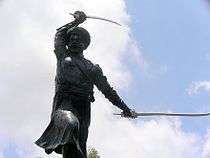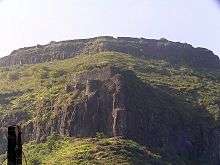Murarbaji
Murarbaji Deshpande (17th century) was a general in the early Maratha Empire during the reign of Shivaji Maharaj. He is best remembered for his defense of the Purandar Fort against Dilir Khan, a Mughal general who accompanied Mirza Raja Jai Singh in the 17th-century siege on Purandar.[1]
Murarbaji | |
|---|---|
 Statue of Murarbaji Deshpande at Purandar Fort. | |
| Born | Mahad |
| Occupation | military general |
Early life
Murarbaji Deshpande was born into a Chandraseniya Kayastha Prabhu or CKP[2] family and his native land was the Kinjaloli near Mahad, Raigad District. He was the gallant commander who commanded 700 mavle (maratha troop) to attack Diler Khan.[3]
History
The battle for Purandar fort was a landmark battle of symbolic importance for both the Marathas and Mughals. It was essential for the Marathas to hold off the Mughals for as long as possible, thus demonstrating the difficulty of conquering the mountainous Maratha Empire. It was equally imperative for the Mughals to conquer Purandar as swiftly as possible to demonstrate the futility of resistance of the dominant Mughal empire.

In the end, superior European cannons fielded by the Mughals, under the leadership of the European mercenary Mannucci, blasted away the walls of Purandar. In spite of crumbling defenses, Murarbaji and his troops sustained a dogged defense. When the Mughals breached the outer walls, Murarbaji and his soldiers, though overwhelmingly outnumbered, mounted a fierce counterattack. Maratha folk history has it that Murarbaji showed incredible skills as a swordsman and was an aggressive and inspiring leader who pushed back and caused a retreat of a larger Mughal force.
Diler Khan, impressed with the bravery of Murarbaji, offered him a truce and employment in the Mughal forces with a handsome salary. Murarbaji turned down the offer due to his loyalty to the ideals of Hindavi Swarajya. He was extremely enraged at this very suggestion and in an act of extreme daredevilry charged with his commandos right into the heart of the Mughal troops, killing hundreds. The remaining Marathas retreated inside the inner walls (baalekilla) of the fort, refusing to surrender and willing to fight to the last man.
The battle of Purandar showed the Marathas the difficulty in facing the overwhelming force led by Mirza Raja Jai Singh, and revealed to the Mughal the tenacity of the Marathas. Thereafter Shivaji agreed to surrender to Mirza Raja rather than risk the decimation of his forces and the ruin of his homeland. Aurangzeb sought to sign the treaty of Purandar and invited Shivaji to Agra rather than face a protracted and expensive campaign to conquer Marathas. As a part of the settlement Shivaji agreed to give up 23 of his forts and 4,00,000 hons to the Mughals. He also agreed to let his son Sambhaji become a Mughal Sardar and serve the Mughal court of Aurangzeb.
References
- "Murarbaji Deshpande". Brad Beaman. 2011-08-13. Retrieved 2019-06-22.
- Kantak, M. R. (1978). "The Political Role of Different Hindu Castes and Communities in Maharashtra in the Foundation of the Shivaji's Swarajya". Bulletin of the Deccan College Research Institute. 38 (1): 46. JSTOR 42931051.
Among Shivaji's [chandraseniya] kayastha prabhu officers, the names of Baji Prabhu Deshpande, Murarbaji Deshpande, Babaji Prabhu and Yeshwantrao Buvaji Prabhu have become famous in Maratha history. Baji Prabhu fell fighting against the forces of the Bijapur government near Vishalgad in 1660. Murarbaji died a hero's death while defending the fort of Purandar against the Mughal forces of Jaisingh in 1665
- History of Aurangzib: Based on Original Sources, Volume 4 By Sir Jadunath Sarkar